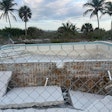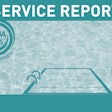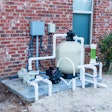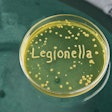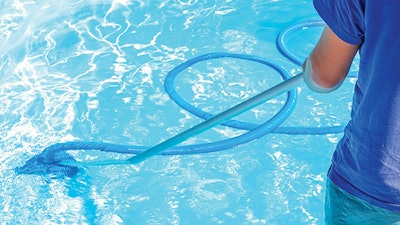
Over the past few years, if you have stayed current with our industry news, you may have heard something about CYA and what levels it should be at to keep a pool safe and the discussion that follows: What happens when it gets too high and creates problems?
We have all heard the phrases “the only solution is dilution” or “just drain and refill it” — that’s been the only way to get CYA out of a pool. Well, what if I told you there was another way to lower your levels without having to drain your pool? Draining and refilling thousands of gallons of water may not be an issue for some of us, but this process could prove valuable to those who are on water restrictions or who simply want to conserve.
About a year ago at the IPSPE in New Orleans, Rudy Stankowitz announced a method of CYA extraction out of a swimming pool. What did he announce based on his research? A coagulation agent involved in water purification, otherwise known as Aluminum Sulfate, or Alum for short, will remove some CYA OUT OF YOUR POOL WATER as part of its coagulation process. It also reduces phosphates and removes other impurities at a microscopic level. Those benefits of this treatment are not my focus today, nor is the geeky chemical talk. My main point of this article is to say we have had SUCCESS REDUCING CYA with this method. Let’s start with the method before we get to the results.
Alum-CYA Removal Method:
1. Adjust pH to 7.0 (this is critical).
2. Adjust Total Alkalinity to 80-120 ppm, Calcium Hardness to 200-400 ppm, Water Temperature to 70-90 degrees Fahrenheit (this is critical).
3. Ensure the pool is free of heavy debris that could stir the ‘floc’ upon vacuum to waste.
4. Test Cyanuric Acid Level.
5. Filter Preparation —
- Sand and DE Filters: With the pump off, manipulate the multiport valve to ‘recirculate’ position.
- Cartridge Filters: With the pump off, remove the filter element and then reassemble without it.
6. Broadcast Aluminum Sulfate at a rate of 8.33 lbs per 10,000 gallons of water.
7. Set the time clock to run the pump for two hours and then shut off.
- Remove the ‘ON’ tripper from the time clock or set automation to service, and set an egg timer to avoid unintentional circulation.
8. Allow the pump to remain off for a minimum of 12 hours. Do NOT allow the pump to run again until the entire process is complete, and elements are replaced with valves in the correct run positions.
9. With a PORTABLE VACUUM SYSTEM, vacuum the floc to waste at a pace slow enough not to stir or ‘break’ the floc.
10. Test residual aluminum level (should be < 0.2 ppm).
11. Test Cyanuric Acid level. Overall, it is a fairly simple process to do. The pH, alkalinity and water temp are critical. Get those three parameters set, calculate your pool volume, measure your doses and follow these instructions above for some clear water, a happy client and a smile on your face. If you have yet to do a treatment like this, it is a cool process. The water clouds up, and when you come back the next day, it’s all sitting on the bottom of the pool just waiting to be vacuumed out. Grab your tools and equipment, clean it up, refill/ rebalance the water, and you’re done.
WITNESS THE RESULTS
Plenty of people can attest this method works. Here are just two professionals that have seen good results:
“I personally have seen almost a 50% drop in CYA by adding just 8 lbs of alum per 10K of water in a little over 12 hours on a 19,000-gallon pool with a water temp of 80 degrees.”
—John Poma, A+ Pool Service, Lakeland Fla.
“Alum has been our go-to when needing to quickly reduce CYA without draining water. We have dropped levels up to 10 ppm with a light dose of only 3 lbs per 10,000-gallons in one treatment.”
—Aimee Clark Olds, All N One Pools, Lafayette La.
From a small but growing number of field tests, we have seen drops in CYA levels consistently in the 20-30% range. I used a SpinLab to test my trials and saw drops in CYA ppm from 165 to 130 and 140 to 115. I am in Florida where we see 5 feet of rain a year, so we tend to not see crazy high amounts of CYA like I hear about in other places. The other people I have spoken to and the ones who have been posting their numbers online are all seeing similar, successful results. From the data we have, we are starting to see that this is becoming a viable option for CYA reduction in a swimming pool. Alum has been used in water treatment dating all the way back to ancient Egypt, so it is not a fancy new product that took 20 years to develop or costs a fortune to buy. But it is an effective water purifier. The process is not new, just the findings.
Now, obviously there needs to be more testing done to gather more data and verify results. The discussion on this process over the past year has been mostly positive, but we could use some more people to help us gather more data and test this theory. That’s where you come in. Check out the research we’re doing and add some of your own.
A few of the Facebook groups involved in this discussion are Talking Pools and 14PSI Pool Industry Lounge. We would love to hear your feedback on this — pool pro to pool pro. With everything that has happened in 2020, we are effectively using social media groups like the two mentioned above to help others and promote better practices while still staying safe. We are all looking forward to your insight into making our industry better for all involved.
Dustin Weaver owns Ever Blue Pool Care in Sarasota, Fla. He holds a BA in Information Systems, is the President of his IPSSA chapter and is devoted to making the industry better. He has yet to fall in a pool.
This article first appeared in the February 2021 issue of AQUA Magazine — the top resource for retailers, builders and service pros in the pool and spa industry. Subscriptions to the print magazine are free to all industry professionals. Click here to subscribe.


































